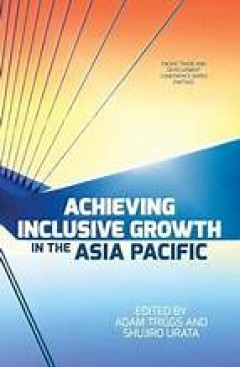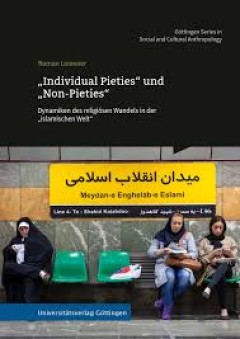Filter by

Afterlives of war
Afterlives of war documents the lives and historical pursuits of the generations who grew up in Australia, Britain and Germany after the First World War. Although they were not direct witnesses to the conflict, they experienced its effects from their earliest years. Based on ninety oral history interviews and observation during the First World War Centenary, this pioneering study reveals the co…
- Edition
- -
- ISBN/ISSN
- -
- Collation
- -
- Series Title
- -
- Call Number
- -

Achieving Inclusive Growth in the Asia Pacific (Paftad)
The world’s developed economies are experiencing a sharp backlash against globalisation, and it appears to be contagious. Will Asia catch it next? Asia has seen spectacular growth in recent decades. It has benefited substantially from global trade, finance, openness and the rules-based international order. But much of the growth Asia has enjoyed has not been shared. It has not been inclusive …
- Edition
- -
- ISBN/ISSN
- 978-1760463816
- Collation
- oer.unej.ac.id
- Series Title
- -
- Call Number
- -

A Greek State in Formation: The Origins of Civilization in Mycenaean Pylos
Although the Mycenaean civilization of the Greek Bronze Age was identified 150 years ago, its origins remain obscure. Jack L. Davis, codirector of excavations at the Palace of Nestor at Pylos, takes readers on a tour of the beginnings of Mycenaean civilization through a case study of this important site. In collaboration with codirector Sharon R. Stocker, Davis demonstrates that this ancient pl…
- Edition
- -
- ISBN/ISSN
- 9780520387256
- Collation
- 168 hlm
- Series Title
- -
- Call Number
- -

A Delicate Choreography: Kinship Practices and Incest Discourses in the West …
The origins of the incest taboo have puzzled many of the most influential minds of the West, from Plutarch to St. Augustine, St. Thomas Aquinas, Martin Luther, David Hume, Lewis Henry Morgan, Sigmund Freud, Emile Durkheim, Edward Westermarck, and Claude Le?vi-Strauss. This book puts the discussion of incest on a new foundation. It is the first attempt to thoroughly examine the rich literature, …
- Edition
- -
- ISBN/ISSN
- 978-3111009247
- Collation
- 1134 hlm
- Series Title
- -
- Call Number
- -

Accustomed to Obedience? Classical Ionia and the Aegean World, 480–294 BCE
Many histories of Ancient Greece center their stories on Athens, but what would that history look like if they didn't? There is another way to tell this story, one that situates Greek history in terms of the relationships between smaller Greek cities and in contact with the wider Mediterranean. In this book, author Joshua P. Nudell offers a new history of the period from the Persian wars to war…
- Edition
- -
- ISBN/ISSN
- 978-0-472-90387-0
- Collation
- oer.unej.ac.id
- Series Title
- -
- Call Number
- -

A World without Capitalism?
- Edition
- -
- ISBN/ISSN
- 9781000484434
- Collation
- oer.unej.ac.id
- Series Title
- -
- Call Number
- -
- Edition
- -
- ISBN/ISSN
- 9781000484434
- Collation
- oer.unej.ac.id
- Series Title
- -
- Call Number
- -

A World Trading System for the Twenty-First Century
When designing a world trading system for the twenty-first century, “Keep calm and carry on” beats “Move fast and break things.” Global trade is in trouble. Climate change, digital trade, offshoring, the rise of emerging markets led by China: Can the World Trade Organization (WTO), built for trade in the twentieth century, meet the challenges of the twenty-first? The answer is yes, Robe…
- Edition
- -
- ISBN/ISSN
- 9780262371292
- Collation
- oer.unej.ac.id
- Series Title
- Ohlin Lectures,
- Call Number
- -

„Individual Pieties“ und „Non-Pieties“: Dynamiken des religiösen Wan…
-
- Edition
- -
- ISBN/ISSN
- 978-3-86395-557-1
- Collation
- -
- Series Title
- -
- Call Number
- -

The Ndebele, Frank Oates, and Knowledge Production in the 1870s = Encounters …
This open access book addresses a question fundamental to the histories of empire and Africa: at the point of the colonial encounter, how was knowledge made? How did different communities, with little or no prior contact, construct meaning about one another? Amidst huge changes in the politics and economics of a continent, on the cusp of almost complete colonization at the hands of European pow…
- Edition
- -
- ISBN/ISSN
- 9783031759635
- Collation
- IX, 125 hlm; ill., lamp.,
- Series Title
- -
- Call Number
- -

WTO Law and Trade Policy Reform for Low-Carbon Technology Diffusion = Common …
The open access publication of this book has been published with the support of the Swiss National Science Foundation. In WTO Law and Trade Policy Reform for Low-Carbon Technology Diffusion, Zaker Ahmad puts a spotlight on the crucial importance of dismantling market barriers and offering incentives to improve clean technology access and diffusion across borders. To that end, the author argues…
- Edition
- -
- ISBN/ISSN
- 9789004446090
- Collation
- 324 hlm; ill., lamp.,
- Series Title
- -
- Call Number
- -
 Computer Science, Information & General Works
Computer Science, Information & General Works  Philosophy & Psychology
Philosophy & Psychology  Religion
Religion  Social Sciences
Social Sciences  Language
Language  Pure Science
Pure Science  Applied Sciences
Applied Sciences  Art & Recreation
Art & Recreation  Literature
Literature  History & Geography
History & Geography